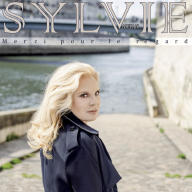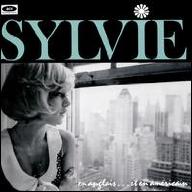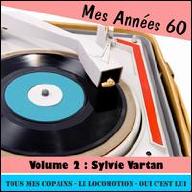Vartan was born Sylvie Georges Vartanian in Iskretz, Bulgaria during WWII, seven years after her brother Eddie. Her parents were originally from Georgia and worked for the French embassy. After Bulgaria was invaded by the Soviets in September 1944 -- a month after her birth -- the Vartan's house was confiscated, prompting the family to relocate to Bulgaria's capitol and largest city, Sofia. Due to changing circumstances in the country, they decided to leave and emigrated to Paris, France, arriving in December 1952 after a three-day train ride. They were shocked at the abundance of food, gifts, and other products readily available for purchase. Georges Vartan procured work as a night porter and the family stayed in a hotel for several years, cramped in a single room. The children, who could not speak a word of French, found it difficult to adapt. Nevertheless, through sheer hard work, Sylvie managed to pass her entry exam to the Lycée Victor Hugo.
In 1960, the Vartans moved into an apartment. Sylvie entered the Hélène Boucher Lycée for Girls. Her mother advised her to specialize in foreign languages, at which she seemed gifted. That advice would serve her well in the future. Around this time, she began to take an interest in rock & roll (Bill Haley and Elvis Presley) and jazz -- her bother had become a professional trumpeter). That same year, Eddie gave up his legal studies to become first an artistic director for RCA France, and then a record producer. Almost immediately he persuaded his sister to sing a duet with Frankie Jordan -- "Panne d’essence" -- released as the flipside to one of his singles. Unexpectedly, the B-side became the hit and Vartan, uncredited on the sleeve, received her first opportunity to sing on television. She was well-received by the press, which dubbed her "la collégienne du twist" ("the twisting schoolgirl"). By the fall of 1961, she had signed her own deal with Decca and that December issued her debut EP, whose hit track was "Quand Le Film Est Triste," a cover of Sue Thompson's "Sad Movies (Make Me Cry)." The label rushed out her version of Ray Charles' "What'd I Say," and put her on-stage at the L'Olympia that same month as the opening act for Vince Taylor. In July of 1962 she toured the country with Gilbert Bécaud and performed in her second concert at L'Olympia with Johnny Hallyday. In autumn she released her version of "The Loco-Motion" and her first LP, simply titled Sylvie, followed shortly thereafter with the single "Tous Mes Copains." Vartan also had her first adult part in a movie playing a singer in the film Un Clair de Lune à Maubeuge. In 1963, Paul Anka offered her the song "I'm Watching You," which became her first international hit in Japan and Korea, resulting in the smash LP Twiste et Chante. She rounded out the year with four TV specials and became the doyenne of teen magazines. Of the 32 tracks she released between 1962 and 1963, six landed in the European Top 20. Late in 1963, Vartan toured France with Johnny Hallyday and starred with him in the movie D'où Viens-Tu, Johnny? Shortly thereafter, they traveled to Nashville to record with the Jordanaires, resulting in the album À Nashville. The pair were engaged in 1964, just before Hallyday went to perform his compulsory military service, and Vartan released her self-titled album, which proved her entry into the yé-yé universe. Its single, "La Plus Belle Pour Aller Danser," became her most recognizable hit. Eddie Vartan hired two English songwriting session musicians, Tommy Brown on drums and Mick Jones (later of Foreigner) on guitar. All went to record in New York City, where they penned Sylvie's hit "Cette Lettre-Là." The track marked her first TV variety show performance on the Ed Sullivan Show as a promo for her full-length Gift Wrapped from Paris.
Vartan and Hallyday married in 1965 and gave birth to a son in August of 1966. Though she took a couple of months off, she recorded and released more hits in 1966 and 1967, all of which were delivered in television variety show appearances, including "Dis Moi, Que Tu M'aimes" (where she was accompanied by a group of male dancers) and "Le Jour Qui Vient" in early 1968; both hit number one in France, as did "2'35 de Bonheur" and "Comme Un Garçon." These tracks all registered chart success in Italy, Belgium, Japan, and Korea as well. In April, Vartan sustained serious injuries in an automobile accident, but she recovered quickly and was back in the studio and on television, as well as at the L'Olympia by December. The following year, Vartan delivered nine Saturday night appearances on Italy's national television station, which aided her single "Zum Zum Zum" in becoming a hit. She toured the globe in the aftermath and returned to Italy for more shows, including a television special. Her sophisticated, proto-Las Vegas stage show gained press notice across Europe for her numerous costume changes and dance routines. In 1970, she was involved in a second serious car accident, this time with Hallyday. He was unharmed, but Vartan was seriously injured. Extensive plastic surgery on her face was required. She convalesced in New York, where she met Jojo Smith, Barbra Streisand's choreographer, who masterminded her future American-style review shows. Nonetheless, by year's end she was back. She performed at L'Olympia and toured Japan the following spring; she was warmly received for recording three songs in Japanese. She returned to the cinema, acting in director Harry Kumel's Malpertuis; the film also featured Orson Welles in its cast.
With her American-style stage show -- complete with a large chorus of backing singers -- at L’Olympia in December of 1972, she offered audiences more rock-based material, but did cover Jacques Brel's "Ne Me Quitte Pas" and "Mon Père," the latter offered as a tribute to her father, who died in 1970. In 1973, she cut her first duet with her husband. The single "J’ai un Problème" quickly attained gold certification. The pair toured that summer before Vartan undertook another Japanese tour, which resulted in an acclaimed, best-selling double-live album. From March to May of 1975, she appeared on Italian TV in the eight-episode series Punto e Basta and followed it with a summer tour with Jean-Jacques Debout that culminated in a concert with Hallyday in Narbonne. In October she planned a series of performances at the Palais de Congrès in Paris, a larger venue than she was used to in France; she hired the American choreographer Walter Painter to coach her army of dancers. The most vampish of French singers in elaborate costumes triumphed in those concerts and shows, and resulted in an ensuing tour. Following these activities, Vartan took a sabbatical to the U.S. with her son. She returned to the Palais de Congrès for a new show in 1977, Qu’est-ce Qui Fait Pleurer Les Blondes?, after her 1976 album of the same name. Her concerts added more dazzling touches to her singing.
Albums released during the '70s, including Je Chante Pour Swanee, Shang Shang A Lang, Fantaisie, and I Don't Want the Night to End, all charted in Europe and Japan.
In 1980, Hallyday and Vartan divorced after 15 years of marriage. In 1981, she opened a performance school in Paris, and followed it the next year with two more schools in Japan. She also released the acclaimed, best-selling full-length De Choses et D’Autres. 1981 was also the year she met her future husband, producer Tony Scotti, who would later become one-half of Scotti Brothers Records. In November, backed by the American dancer and singer Gene Kelly, she performed at the MGM Grand in Las Vegas. This ultimate test for the "yéyé girl next door" ended in a standing ovation. While her live shows on either side of the Atlantic or Pacific were always sold-out events, her record sales were lackluster: 1984's Made in the USA and Virage in 1985 both sold poorly in comparison to earlier efforts, resulting in her leaving RCA after a quarter-century. Vartan married Scotti in 1984. After a four-year break, she returned with 1989's Confidanses. The first two singles, "C’est Fatal" and "Il Pleut Sur London," both scored on the charts, but "Quand Tu Es Là," a re-visioned 1965 hit arranged by Etienne Daho, hit the top three. She also took part in the recording of the benefit album Urgence: 27 Artistes Pour La Recherche Contre Le Sida to assist AIDS victims.
At the end of 1990, Vartan returned to Bulgaria for the first time since she was eight and gave a concert. In 1991, encouraged by her husband and aided by Daho, she gave a concert tour of her earlier hits entitled "Je Vous Salue Paris." While its reception at home was lukewarm, it was well-received in Japan and Italy. In 1992 she issued the album Vent d’Ouest, arranged by Claude Gaudette. While it gained exceptionally positive critical notice, it sold only modestly. She spent 1993 acting in various films before returning to issue the unplugged set Sessions Acoustiques in late 1994. Her show at the following year's Casino de Paris supported the date as she banished the high-rent glitz and excess of earlier tours and instead presented the show as a more intimate affair -- to great critical notice -- though not all costume changes were forsaken. In the fall of 1996, she issued Toutes Les Femmes Ont un Secret, with tunes by a who's-who of hit songwriters including Luc Plamondon, Richard Cocciante, Jean-Louis Murat, Marc Morgan, and Yves Simon. The critical and fan acceptance of this mature sound was universal. In November, she sang at L’Olympia again -- the legendary site of her yéyé years. Vartan wore the same Yves Saint-Laurent dress she'd worn for her début on its stage. She sang only hits, including those from the '60s, beginning with "La Plus Belle Pour Aller Danser."
As a mother to a pair of daughters as well as a Bulgarian child named Darina, Vartan took time off to devote herself to parenthood. She issued two children's' albums in 1997 and 1998, and didn't give a damn what the public thought of them. But she had something for her fans, as well. Vartan cut Sensible for Philips, which was released that October. Material came from the many veterans she'd worked with in the past, as well as new collaborators who included Michel Jouveaux, Jay Alanski, and the duo of Marc Lavoine/Aboulker. Her son David Hallyday also penned material for the album. In November, French president Jacques Chirac presented her with the prestigious Légion D'Honneur for her lifetime achievements and contributions to French culture. Vartan returned to touring in 1999 with a concert filled with classic songs from the great chanson era of the 1930s and '40s, as well as her own hits. Not one to shy away from glamour, Vartan hired Jean-Paul Gaultier to design her costumes and Painter for the choreography. The pomp and circumstance resulted in the best-selling Tour de Siecle live album. Vartan didn't release another album until she was 60, in 2004. She published her autobiography, Entre Ombre et Lumière and released Sylvie, written in collaboration with a loyal band of songwriters including Didier Barbelivien, Michel Mallory, and David Hallyday. It was a showcase for the classic Vartan at her pop diva best. Besides featuring contributions from her faithful partners, she included songs from up-and-coming stars including Daran and Florent Marchet. A double-length greatest-hits set followed, as did a box set of seven live albums. She supported all of them with two weeks of shows at Palais des Congrès, and an extensive tour of Geneva, Brussels, and Tokyo. The fashion industry got in on the act, too: Musée Galliera paid its own tribute by organizing an exhibition of Vartan's original stage costumes. The exhibition ran from October of 2004 to February of 2005 and featured 80 stage costumes and personal outfits from the singer's wardrobe, from her "yé-yé" period to the present. In 2006, she received the Ordre National du Mérite Award presented by the French minister of Culture and Communications, Renaud Donnedieu de Vabres. He hailed her as "one of the most prestigious ambassadresses of French chanson and French chic" and a "woman with a big heart who has used her international fame to spearhead her campaign against poverty and misery in the world...." In fact, throughout her career, the singer remained deeply attached to her homeland. In 1992, she set up the Sylvie Vartan Association for Bulgaria, providing valuable aid to children in need via donations and the provision of medical equipment for pediatric hospitals.
In 2007, Vartan released Nouvelle Vague, a covers set featuring her own versions of '60s classics by the Rolling Stones ("Ruby Tuesday"), the Beatles ("Drive My Car"), sister yé-yé artist Françoise Hardy ("Le Temps de L'Amour"), and French adaptations of Leonard Cohen's "Suzanne" and Bob Dylan's "Blowin’ in the Wind." All the songs were set to simple, basic arrangements that emphasized the rich timbre of Vartan's voice. She also campaigned to free five Bulgarian nurses who'd been imprisoned and sentenced to death in Libya eight years earlier. Relentlessly pursuing a series of petitions, appeals to the French president, and appearances in the media, Vartan played a high-profile role in the campaign that had been organized by Lawyers Sans Frontiers. The nurses were released and returned home to Bulgaria in July 2007.
After a long international tour, Vartan returned to work on a new album entitled Soleil Bleu. Upon the advice of Daho, she met with Keren Ann and the singer Doriand; they wrote two songs for her in "J’fais La Moue" and "Je Me Détacherai," and produced her album, released by RCA at the end of 2010. All the young faces of French chanson were invited to take part writing for and playing on the album. The title song was written and interpreted in a duet with Julien Doré; Vartan and Arthur H duetted on a cover of Benjamin Biolay's "La Vanité." She also sang tailor-made lyrics by Daho, La Grande Sophie, Frédéric Botton, and son David. To celebrate the release of Soleil Bleu, Vartan did a one-off performance at the Théâtre du Châtelet in Paris in December. Many hits were on the program, but she also performed newer songs, including duets with Doré and Arthur H, who joined her on-stage. She then embarked on a sold-out tour to present her new songs live across Europe.
Vartan issued a 50th anniversary live album entitled Live a La Salle Pleyel: The 50th Anniversary Concert in 2011 before taking a breather. In 2013, she returned to a Nashville studio to celebrate the 50th anniversary of her Music City album. Sylvie in Nashville included songs by Bob Seger, Kristian Bush, and Roy Orbison, as well as some custom-penned originals. To her surprise, the album charted at home and across Europe. In 2015, BMG/Sony Legacy issued Une Vie en Musique, a special-edition retrospective that included tracks from her catalog associated with Sofia, Bulgaria, Paris, and Los Angeles. She delivered a new studio recording entitled Avec Toi... in 2018. Produced and arranged by Michael Lloyd and recorded by Rob Kearney, the 15-song set featured works by late ex-husband Johnny Hallyday (and their son David), Aznavour, Gilles Thibaut, and Lennon & McCartney. ~ Thom Jurek, Rovi

















